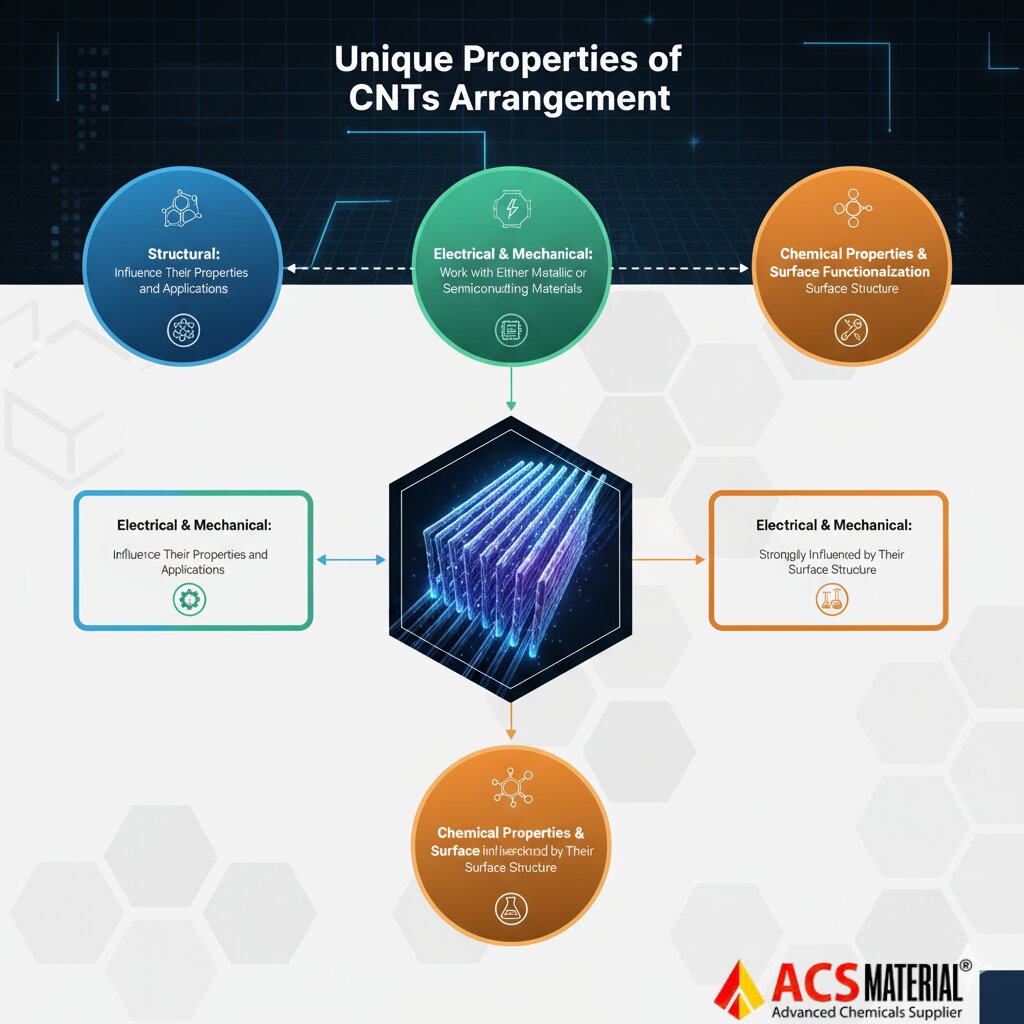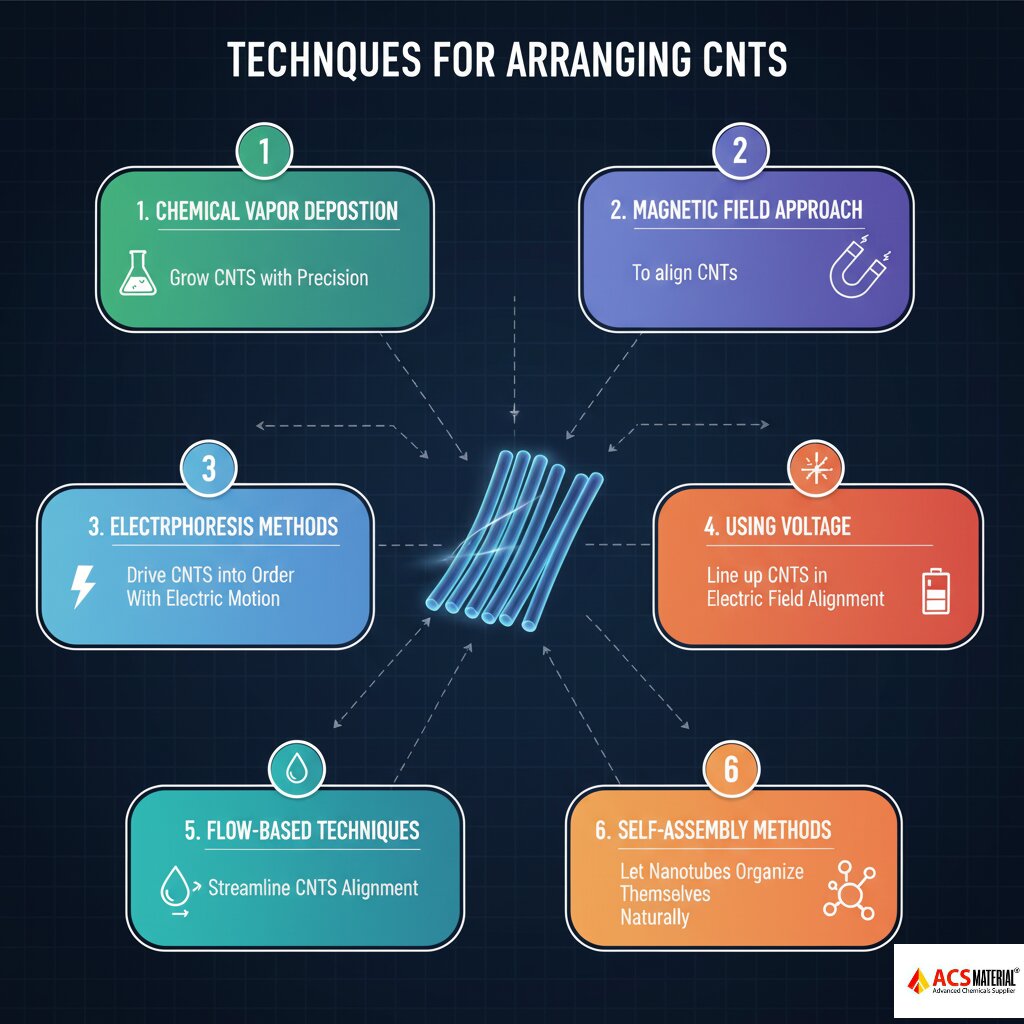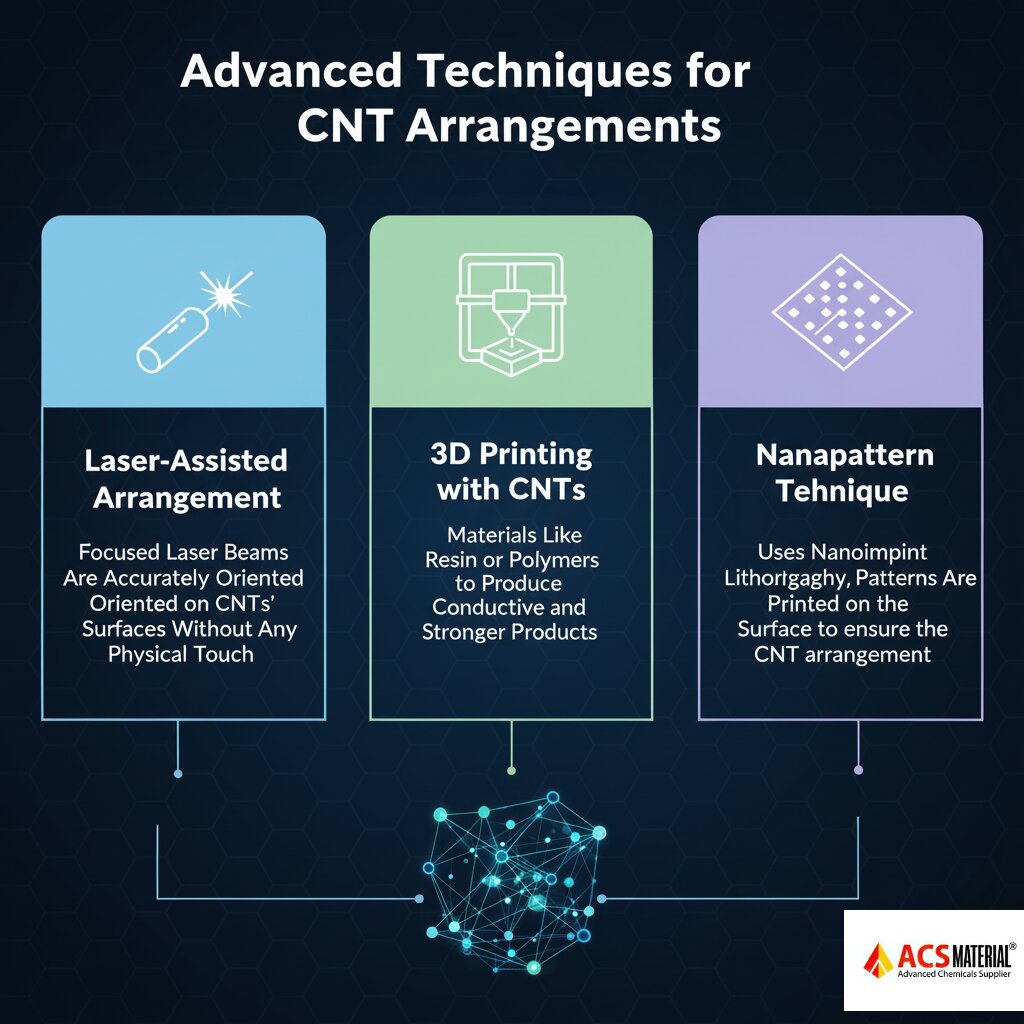-
How to Arrange Carbon Nanotubes (CNTs)?
Nov 14, 2025 | ACS MATERIAL LLCCarbon nanotubes (CNTs) are transforming industries and their future with noteworthy properties. These properties include mechanical strength, chemical resilience, and electrical conductivity. Let’s see three significant types of CNTs before diving into further discussion.
- Single-walled carbon nanotubes (SWCNTs) become worthy due to their conductivity and flexibility.
- Double-walled carbon nanotubes (DWCNTs) are used to enhance durability and high stability.
- Multi-walled carbon nanotubes (MWCNTs) are valued for scalability and strength.
In addition to this, the precise arrangement of CNTs is mandatory to unlock their full potential as alignment increases their electronic and optical properties. It ensures reliability and performance in advanced applications. This blog explains how to arrange the carbon nanotubes using the best methods and techniques.
Understanding The Unique Properties of CNTs Arrangement
Carbon Nanotubes are highly adaptable nanomaterials with excellent properties that make them useful in diverse areas like material engineering, electronics, and biotechnology. The arrangement of CNTs improves the overall performance and functionality. Let’s see the unique structural characteristics of CNTs.
Structural Characteristics of CNTs
Studies and research show that the structural characteristics of CNTs imperatively influence their properties and applications. Additionally, the factors of the single-walled carbon nanotubes’ chirality and diameter determine their optical and electrical behavior. Their long and thin shape also makes them incredibly controlling of these structural parameters. Mastering these traits enables the specific use of CNTs from advanced biomedical systems to flexible electronics.
Electrical and Mechanical Characteristics
CNTs show remarkable mechanical and electrical qualities; therefore, they work with either metallic or semiconducting materials based on their structure. CNTs are famous for their tensile strength and flexibility at the same time. And, these properties make it an ideal option for more advancements in material sciences.
Chemical Properties and Surface Functionalization
The chemical Properties of CNTs are strongly influenced by their surface structure. Moreover, the pristine CNTs do not mix well with liquids or other materials because they are chemically clumped together. To enhance their benefits, scientists modify the surfaces.
In covalent functionalization, new chemical bonds connect directly to the CNT’s surface. And makes them better at connecting with polymers, biochemicals, or even metals. However, it can change their original properties slightly.
On the other hand, non-covalent functionalization molecules are adhesive to the CNT’s surface without changing the CNT’s internal structure. It ensures the integrity of the original mechanical and electrical strength and improves them for dispersing and reacting.
Such surface tweaks support CNTs to integrate more seamlessly into composites, sensors, and biomedical devices by improving their alignment.
Preparation for CNTs Arrangement
The perfect alignment of CNTs requires preparation for seamless performance and peaks. The preparation phase helps the scientists and experts to remove the impurities and ensure structural uniformity, which impacts the compatibility of nanotubes with substrates.
Purification and Sorting of CNTs
Purifications and sorting are the phase where scientists optimize the qualities of CNTs. They remove impurities like amorphous carbon, structural defects, and metal catalysts in nanotubes. Methods of purification that are used by experts are here:
- Centrifugation
- Density gradient ultracentrifugation
Similarly, sorting also helps to improve the CNTs' functionality. Sorting separate single-walled from multi-walled carbon nanotubes and metallic from semiconducting types. For sorting, professionals trust the listing methods.
- Dielectrophoresis
- Chromatography
Thus, purification and sorting processes aim to improve uniformity, performance, and alignment. It enables CNTs to be successfully used in transistors and composite materials.
Functionalization of CNTs for Improved Arrangement
Functionalization of CNTs improves stability, compatibility, and the ability to mix evenly for multiple applications. Two types of functionalization are here:
- Covalent functionalization is a technique where chemical groups like hydroxyl and carboxyl are directly attached to CNTs’ surfaces.
- Non-covalent functionalization is a technique where molecules like polymers or surfactants attach without changing the CNTs’ structure.
Techniques for Arranging Carbon Nanotubes
CNTs are exceptional nanomaterials with excellent properties, making them imperative across industries. The precise arrangement of CNTs is mandatory to find out the further potential. Here are different techniques that experts and suppliers use for the arrangement of CNTs.
Chemical Vapor Deposition To Grow CNTs with Precision
Chemical vapor deposition is a popular technique to grow CNTs on substrates with the use of metal catalysts like nickel or cobalt. However, professionals control factors like pressure, substrate type, and temperature that allow CNTs to grow with specific orientations, whether vertically or horizontally.
Apart from that, CVD offers a high-quality, uniform CNT array, the best option for large-area applications. Therefore, this method needs precise control of deposition conditions, which makes it a costly and complex process. Many Reliable Carbon Series Suppliers use CVD methods for the orientation of CNTs.
Magnetic Field Approach for Alignment Of CNTs
When a magnetic field is applied, CNTs tend to align themselves in the same direction as magnetic lines. This helps the experts to control their arrangement more accurately. The magnetic alignment method is beneficial in systems where CNTs require the orientation of other materials.
However, because CNTs are not magnetic by nature, they often need to be combined with magnetic nanoparticles first. Therefore, this approach works best for setups, and it can be challenging to maintain uniform large-scale industrial applications.
Electrophoresis Methods To Drive CNTs into Order With Electric Motion
This popular method is characterized by the aligned carbon nanotube films that use an electric field. In direct current electrophoresis, CNTs are spread in liquid form, and they are aligned along the field. Therefore, this allows it to give a cost-effective and simple way for large-scale applications like films.
In alternating current electrophoresis, they use a time-changing electric field, which gives more precise control over the dispersions and alignment. They are ideal for applications that need high precision, such as sensors and transparent conductive films. Beyond this, electrophoresis methods need more control and complex equipment for CNTs’ alignment.
Using Voltage to Line up CNTs in Electric Field Alignment
Electric field alignment is a method that utilizes a directed electric field to arrange the CNTs suspended in a solution. Additionally, this technique ensures the alignment of the CNTs’ direction with the applied field.
Therefore, it allows the precise control over their orientation, alignment, and density when experts combine with a controlled substrate. Thus, this method is ideal for applications like films, sensors, and nanodevices, where the alignment is crucial.Flow-Based Techniques to Streamline CNTs Alignment
Flow-based solutions use shear forces or fluid to ensure the perfect alignment. In shear force alignment, CNTs suspended in a liquid align themselves along the direction of the fluid flow. Therefore, this technique is suitable for large-scale industries such as composites. Despite this, the flow-based technique often lacks precise control over the exact alignment direction.
Self-Assembly Methods to Let Nanotubes Organize Themselves Naturally
Self-assembly methods allow CNTs to impulsively arrange themselves into patterns under controlled conditions, like temperature, solvent type, and the presence of surfactants. Additionally, this technique is simple, low-cost, and suitable for manufacturing large areas. However, it doesn’t offer perfect control over alignment or uniformity.
Arrangements of CNTs For Particular Applications
CNTs are a unique option of nanomaterials that are known for their amazing electrical, thermal, and mechanical properties. The full potential of CNTs can only be harnessed in specific configurations.
Vertically Aligned CNTs
The vertically aligned CNTs are mandatory for applications to function as nano-sized vertical structures. Methods like magnetic-field alignment, electrophoresis, and chemical vapor deposition are used to achieve this assembly. Vertically aligned CNTs have shown their perks in electronics, catalysis, sensors, electron emission in displays, and offering a large surface area for catalytic reactions.
Horizontally Aligned CNTs
To obtain the CNTs’ horizontal arrangement, professionals use flow-based and dielectrophoretic methods. Additionally, this alignment is mandatory for applications that require high surface area conductivity, such as in conductive films and electrodes. Moreover, horizontally aligned CNTs used in solar cells and OLEDs promise alternatives to older materials like indium tin oxide in flexible electronics.
Randomly Arranged CNTs
Randomly arranged CNTs are beneficial for applications that need a high surface area. Being a cost-effective method, it still improves the mechanical flexibility and surface interaction of nanotubes. The arrangement of CNTs is valuable in industries like automotive, filtration, sensing, and aerospace, where mechanical performance is far important than others.
CNTs Bundling and Aggregation Control
Controlling carbon nanotube bundling and aggregation helps you to optimize their performance in different applications. CNTs often clump together; to separate them becomes harder. Therefore, scientists use methods like surfactants, special solvents, and surface functionalization to fix the issue and keep nanotubes separate and well-dispersed. Furthermore, controlling CNT bundling depends on what the applications need, so sometimes separations work better, and other times bundling gives the best outcomes.
Advanced Techniques for CNT Arrangements
Incredible properties of CNTs make them highly demanding for use in different industries. These are some advanced techniques of CNT arrangement that you must know.
Laser-Assisted Arrangement
This method is powerful because focused laser beams are accurately oriented on CNTs' surfaces without any physical touch. Despite this, the laser-assisted arrangement allows price control over the fabrication of nanoscale devices like nanoelectronics and sensors.
3D Printing with CNTs
Manufacture mixes the CNTs into the 3D printing materials like resin or polymers to produce conductive and stronger products. With the help of this process, industries can make customized designs that align with CNTs for better performance.
Nanopattern Substrate Technique
The method uses nanoimprint lithography, where patterns are printed on the surface to ensure the CNT arrangement. After settling the CNTs, these patterns are followed and make aligned structures. It is also useful for making transistors and memory chips.
Why ACS Material is the Best Carbon Series Supplier?
ACS Material is one of the reputable carbon series materials suppliers, who ensure to deliver authentic and pure materials. We use the CVD (chemical vapour deposition) manufacturing approach for carbon nanotube arrangement. Contact us now to learn about SWCNTs or MWCNTs functionalized nanotubes.
Furthermore, we will provide the highest-quality nanomaterials at the most reasonable price range. Also, stay connected via X(Twitter) or Facebook to buy advanced chemical supplies and their latest updates.Wrap Up the Discussion
The write-up revolves around explaining how to arrange carbon nanotubes and what methods scientists and manufacturers use. In addition to this, the recent advancements in carbon nanotube arrangement methods may increase their mechanical, electrical, and chemical properties.
When CNTs are arranged seamlessly, they create new opportunities for both technological innovations and practical solutions. ACS Material is implementing innovative techniques to align the CNTs, which help advance the next generations and enhance performance.
FAQ’s:
Q. Can carbon nanotubes stop bullets?
A. Yes, the use of carbon nanotubes becomes beneficial for bulletproof materials. However, it doesn’t stop any bullet.
Q. What is the future of nanotubes?
A. CNTs have the best properties, which make them a promising material for future applications in a wide range of industries.
Q. How do you prepare carbon nanotubes?
A. CNTs are prepared using methods like Chemical Vapor Deposition (CVD). In this process, a carbon-containing gas is heated with a metal catalyst to make CNT on a substrate.
Q. Is carbon nanotube technology used in cars?
A. Yes, CNTs are used in cars to improve their strength and heat resistance.
Q. Can nanotubes purify water?
A. Yes, nanotubes have the ability to purify water, because of their high surface area and excellent mechanical strength.
Q. What are the three major types of carbon nanotubes?
A. The major types of CNTs are here:
- Single-walled carbon nanotubes
- Double-walled carbon nanotubes
- Multi-walled carbon nanotubes.
Q. How much does the cost of carbon nanotubes?
A. The CNTs’ price varies depending on type, quantity, and purity. However, multi-walled CNTs cost less compared to other types. On the other hand, single-walled CNTs and high-purity form are expensive according to their quality and properties.
Q. How to get a carbon nanotube?
A. CNTs are produced in laboratories and purchased from specialized carbon series suppliers using methods like CVD, where they grow from carbon sources with the help of metal catalysts.
Q. What are the other names for carbon nanotubes?
A. “Bukytube,” another name for carbon nanotubes, and its abbreviation is CNTs.
Q. Can you cut carbon nanotubes?
A. Yes, CNTs can be cut by using versatile methods, including chemical and physical, according to the person and the length.




